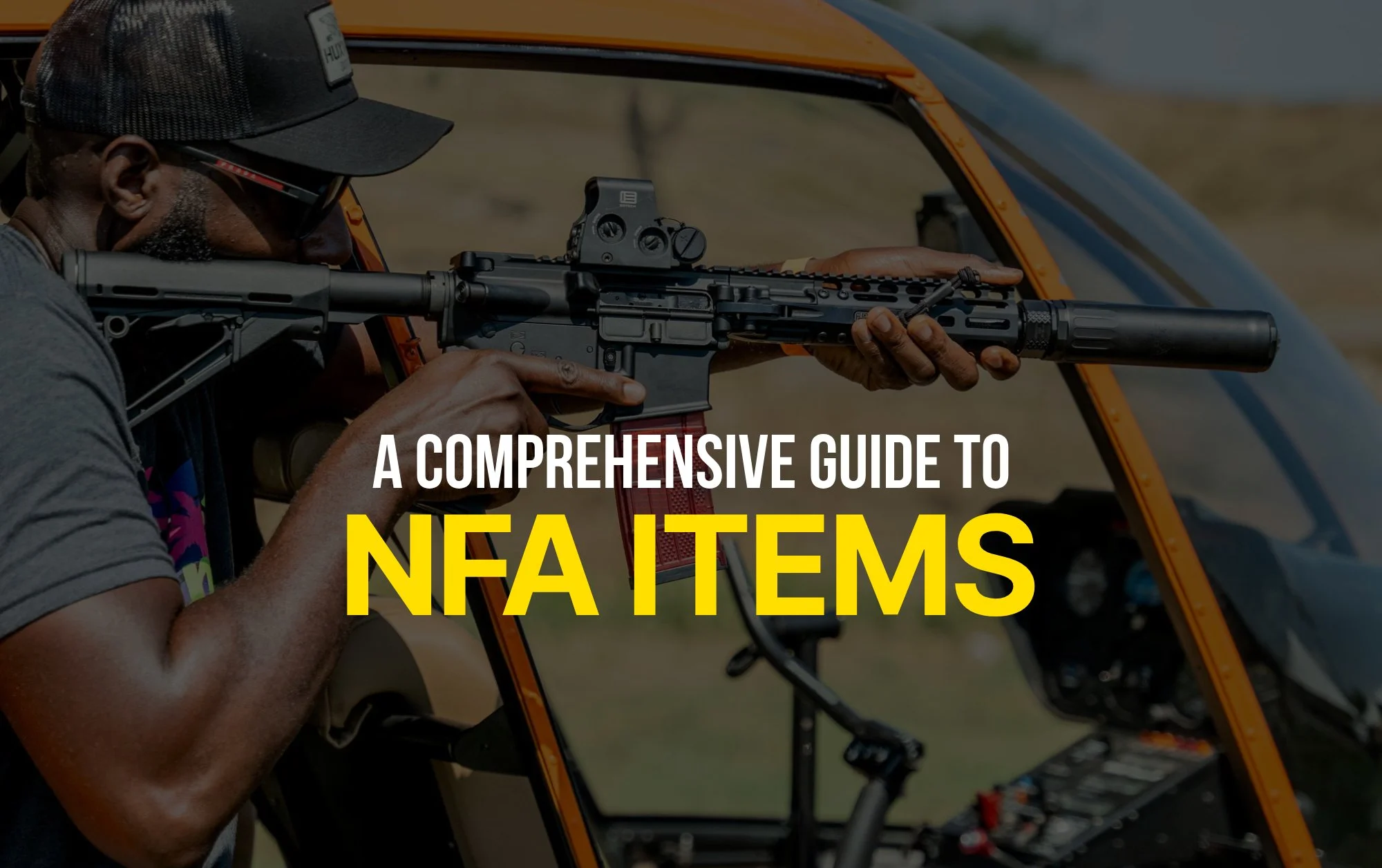In this guide, we’ll walk you through the basics of NFA items, NFA regulations, and the lawful process to own suppressors, full-auto firearms, short-barrel guns, and other NFA weapons.
What Is the NFA?
The National Firearms Act (NFA), passed in 1934, is one of the oldest laws regulating certain types of firearms and weapons in the US. Its main purpose was to make owning and transferring specific weapons harder by imposing strict rules and a $200 tax—which was a lot of money back then! The law covers short-barreled firearms, machine guns (ful-auto firearms), silencers (aka suppressors), and other unique weapons.
Fun Fact: The $200 tax hasn’t changed since 1934.
Why Was the NFA Created?
While the NFA was technically a tax law, its purpose was clear—to restrict, or even stop, transactions involving NFA firearms. Congress believed these firearms were related to crimes, especially gang violence in the 1930s, like the infamous St. Valentine’s Day Massacre.
Key Changes Over the Years
1968 Amendments (Title II of the Gun Control Act)
A 1968 court case made the NFA basically unenforceable. The court ruled that forcing owners of unregistered guns to register them violated their 5th Amendment rights.
To fix this, Congress made changes in 1968:
- They removed the requirement for unregistered firearm owners to register.
- They added protections to ensure registration or application info couldn’t be used as evidence in court.
Note: NFA items are also referred to as Title II Weapons, so these are the same things.
1986 Machine Gun Ban
The next big change came with the 1986 Firearm Owners’ Protection Act. It banned civilians from owning or transferring fully automatic guns made after May 19, 1986. It was still legal to keep if you owned one made before that date.
What Are NFA Items?
Short-Barreled Rifle (SBR)
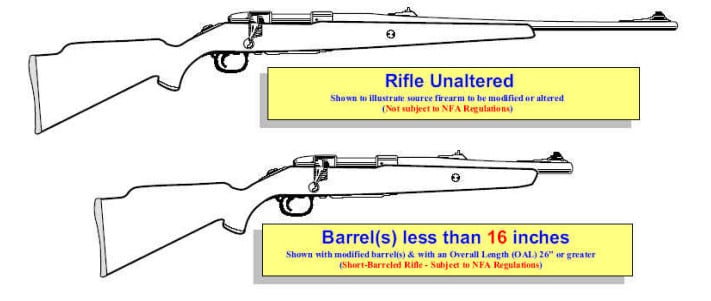
An SBR is a rifle with a barrel shorter than 16 inches, or one that has been modified to have an overall length of less than 26 inches.
Note: An AR pistol looks a lot like a traditional SBR, but it’s not the same. The key difference is that an AR pistol doesn’t have a shoulder stock and is designed to be fired with one hand. Because of this, it isn’t considered a rifle and isn’t subject to NFA regulations. That said, if you add certain accessories or make changes to it, it could be reclassified as an SBR, which would fall under NFA regulations.
Short-Barreled Shotgun (SBS)
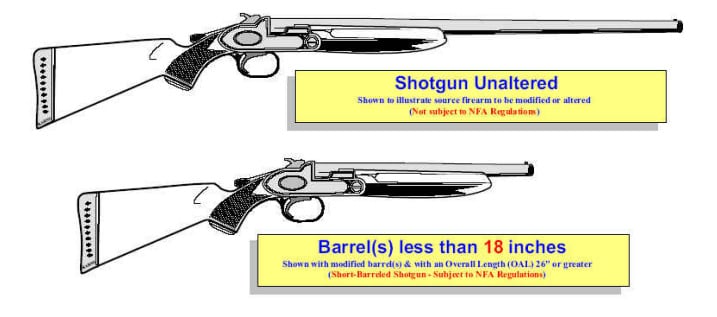
Similar to SBRs, an SBS is a shotgun with a barrel shorter than 18 inches, or a modified shotgun with an overall length of less than 26 inches.
Note: Just like an AR pistol isn’t considered an SBR, a stockless shotgun (e.g. Mossberg 590 Shockwave and similar) is not considered a short-barreled shotgun.
Machine Gun (MG)
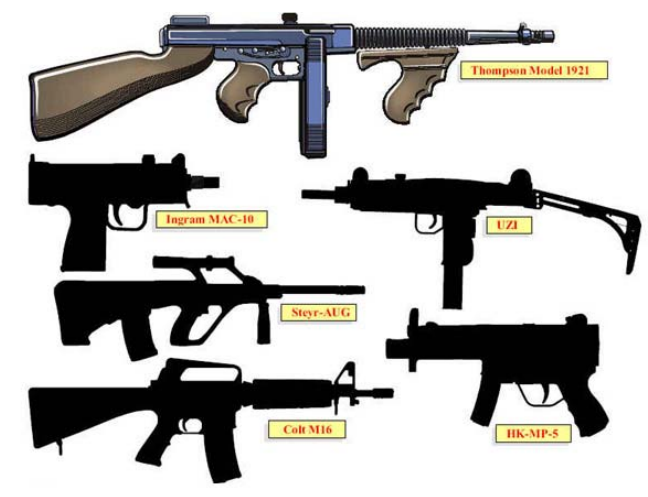
This category includes any firearm capable of firing more than one round with a single trigger pull, without needing to reload. Essentially, fully automatic firearms are considered machine guns under the NFA.
Silencer (Suppressors/SUPP)
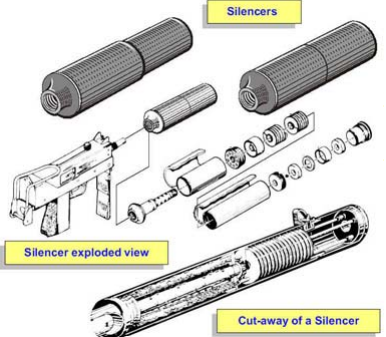
Suppressors reduce the noise a firearm makes when it’s fired. They don’t make your gun completely silent, but they significantly muffle the sound. These devices are also NFA items because they modify the way a firearm operates.
Destructive Device (DD)
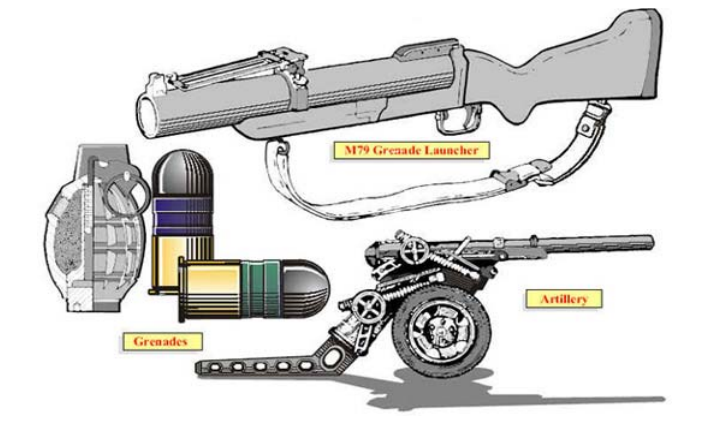
Under the NFA, the term “destructive device” covers a wide range of items. Though the definition can get a little technical, here’s a breakdown to help you understand what qualifies.
Explosive Devices: This category includes things like bombs, grenades, mines, and anything similar that uses explosives, incendiary materials, or poison gases. It also applies to:
- Rockets with a propellant charge of more than 4 ounces.
- Missiles/Projectiles with an explosive or incendiary charge of over 1/4 ounce.
For reference, most projectiles smaller than 20mm caliber don’t have enough space for over 1/4 ounce of explosive, while those larger than 20mm usually do. If you’re looking at 20mm high explosive (HE) or high explosive incendiary (HEI) rounds, know that some qualify as destructive devices, and some don’t—it all depends on how much explosive material they contain. Always confirm the exact specs before assuming they’re excluded.
Large Caliber Weapons: If a weapon has a bore diameter over ½ inch and can fire a projectile using any propellant (explosive or otherwise), it’s generally considered a destructive device. This primarily includes larger military-grade weapons like rocket launchers, mortars, and cannons. One big exception to this rule is shotguns. If the Attorney General determines that a shotgun or its shells are “suitable for sporting purposes,” they’re not considered destructive devices. However, keep in mind, the ATF has classified some shotguns as destructive devices because they didn’t meet this suitability standard.
Exclusions from Destructive Device Classification:
- Devices never designed to be weapons (e.g., signaling or safety devices).
- Items originally designed as weapons but redesigned for non-weapon purposes (e.g., pyrotechnic devices).
- Antique firearms or rifles used exclusively for sporting purposes.
- Military ordnance sold as surplus under certain conditions.
That said, don’t assume an item is excluded just because it looks like it fits one of these categories. For instance, the ATF has ruled that certain pyrotechnic devices qualify as destructive devices. When in doubt, check with the ATF about an item’s legal classification.
Any Other Weapon (AOW)
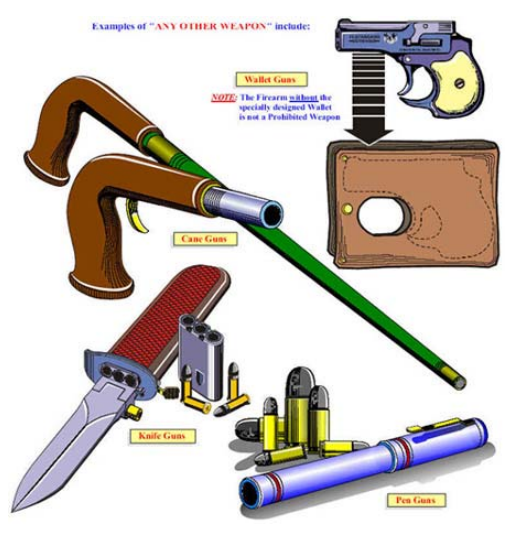
AOW is a catch-all category for unique firearms and devices that don’t quite fit into the other categories. Here’s a breakdown of what qualifies as an AOW:
- Concealable weapons (anything that can be easily hidden on your person and fires a projectile using explosives)
- Smoothbore pistols (a pistol or revolver with a smooth bore (not rifled) designed to fire shotgun shells)
- Pistols with vertical grips
- Dual-barrel guns (guns with rifle and shotgun barrels (12+ inches but under 18 inches), where only one barrel can fire at a time without reloading)
- Restorable weapons (any firearm that can be converted back to working condition)
The following are not considered AOWs under the NFA:
- Pistols or revolvers with a rifled barrel
- Guns designed to be shoulder-fired and that can’t use fixed ammunition
If you’re customizing your firearm, it’s worth double-checking whether it falls under the AOW classification—especially with accessories like vertical grips—since it requires NFA compliance.
NFA Weapons and Class 3
When people refer to NFA weapons as Class 3 firearms, they’re technically mistaken. The NFA splits guns into two groups:
- Title I Firearms: The basics—rifles, shotguns, and handguns—these are what most gun owners are familiar with.
- Title II Firearms: This category includes NFA items—MGs, suppressors, SBRs, SBSs, DDs, and AOWs.
The confusion arises because dealers who handle Title II guns are called Class 3 dealers. The term “Class 3” actually refers to the tax status of federally licensed firearms dealers (FFLs) who pay an annual Special Occupancy Tax (SOT) to deal in Title II weapons.
- Class 1 SOT = Importer
- Class 2 SOT = Manufacturer & Dealer
- Class 3 SOT = Dealer
This is why Title II dealers get the shorthand title of “Class 3 dealers.”
Class 3 SOT sometimes is incorrectly called Class 3 license.
How Can You Own NFA Firearms & Items?
While you can legally buy and own NFA firearms and items, it’s not as simple as picking one up at your local gun shop. If you want to own an NFA firearm or accessory, here’s what you need to know:
Registration Process
To own an NFA item, you must go through a federal registration process with the Bureau of Alcohol, Tobacco, Firearms, and Explosives (ATF). You also must pay a $200 tax (the tax for the transfer (not manufacturing) of AOWs is $5).
State Regulations Vary
Surprisingly, at the Federal level, the process isn’t as complicated as you might think. However, laws differ from state to state. For instance, some states prohibit specific NFA items (like Delaware, which only allows SBRs and AOWs but nothing else). Other states allow all NFA firearms and items but with certain limitations (like Wisconsin allowing to own machine guns but not those chambered in for pistol cartridges). So check in with a knowledgeable FFL in your area or contact your local BATFE field office to ensure everything is legal in your state.
Paperwork, Paperwork, Paperwork
To get approval for owning or transferring an NFA firearm, there are two primary forms you need to know about:
- ATF Form 1 (Make & Register Your Own NFA Item): If you’re planning to build or customize your own NFA firearm (like turn an AR pistol into an SBR or create an SBR from a lower receiver), you’ll need to file Form 1.
- ATF Form 4 (Buy or Transfer an NFA Item): If you’re buying an NFA item from a dealer or private owner, you’ll need to complete Form 4. This application covers the tax-paid transfer and registers the firearm in your name.
Applications (Form 1 or Form 4) will NOT be approved if any federal, state, or local laws prohibit you from owning the item. Be sure you comply with all legal requirements before applying.
Interstate Travel
Moving NFA firearms across state lines can require prior ATF approval. Silencers can cross state lines without prior approval for limited purposes, though approval is still recommended.
Always ensure that NFA firearms are legal in the states you’ll be traveling to or through.
Understanding ATF Form 1 and Form 4
What’s ATF Form 1?
ATF Form 1 (Application to Make and Register a Firearm) is what you need if you plan to legally build or modify a firearm that falls under the NFA. The most common use case here is when a person wants an SBR, and instead of buying a complete rifle, they buy an AR Pistol or a lower and then build their custom SBR off the pistol/lower receiver.
Waiting period: If you e-file your application, expect about 41 days. Paper forms will take 46 days. The ATF’s eForm system speeds everything up. No paper clutter, quicker approvals, and a much simpler process overall. Make sure your details are accurate, or you could get delayed further.
What’s ATF Form 4?
ATF Form 4 (Application for Tax Paid Transfer and Registration of Firearms) is for buying and transferring NFA items from licensed dealers to individuals or gun trusts.
Waiting period: This one takes way longer, from several months to a year. Depending on whether you’re buying as an individual or through a gun trust, wait times vary:
- eForms: 39 days for individuals, 156 days for gun trusts.
- Paper Submissions: 276 days for individuals, 288 days for gun trusts.
If you e-file your Form 4, you can track its progress online. For paper forms, you’ll have to contact the ATF for updates.
ATF Form 1 vs. Form 4—Which Do You Need?
Choose Form 1 if you’re making or customizing a firearm yourself (e.g., building an SBR).
- Pros: Faster approval times (especially on eForms), the opportunity to create a custom firearm.
- Cons: You need to have in-depth knowledge about firearm building and modification and are required to adhere to strict manufacturing guidelines.
Choose Form 4 if you’re buying an NFA firearm from someone else, like a suppressor or pre-made SBR.
- Pros: Easy to get your hands on complex NFA items without having to build them yourself.
- Cons: Be ready to play the waiting game—even eForms take months to process Form 4 applications.
How to Buy an NFA Weapon (Form 4)
If you can pass a general handgun background check, you’re likely eligible to own an NFA item, as long as it’s legal in your state.
Ensure the NFA firearm is registered and will be coming from a licensed dealer (FFL/SOT) within your state. Ownership isn’t official until the BATFE approves the transfer.
Step 1: Pick a Dealer and NFA Item
Shop from your local FFL/SOT dealer or a reputable online vendor specializing in NFA items. If buying online, the seller will first transfer the item to an FFL/SOT dealer in your state via ATF Form 3. Once received, you’ll start your part of the process with Form 4. If not sure which local dealer to use, vendors can help you find one.
Step 2: Gather Your Paperwork
To start your transfer, you’ll need the following paperwork in order:
- ATF Form 4 (in 3 copies—2 for ATF and 1 for CLEO): This document identifies the firearm, its serial number, and the parties involved in the transfer. Fill out your details and answer a few standard “Are you legally eligible?” questions.
- CLEO Notification: You no longer need a Chief Law Enforcement Officer (CLEO) signature but notification is still required. Send a copy of your completed Form 4 to your local CLEO (usually your police chief or county sheriff).
- Passport Photo 2”x2” and Fingerprints (two sets): Include these to complete your application. Your dealer may assist with fingerprinting, or you can visit your local law enforcement agency.
- Trust or Corporation Information (if applicable): If you’re filing under a trust, send all trust documents and include information for every responsible person listed.
Step 3: Pay the $200 Tax Stamp Fee
The NFA requires a $200 one-time tax for most items (except an AOW, which costs just $5). This is submitted alongside your Form 4 and other documents. Your local dealer will collect these and send them to the BATFE on your behalf. Keep in mind the tax is paid per item, so if you’re purchasing multiple NFA firearms, you’ll pay $200 each.
Step 4: Mail Your Application to the NFA Branch
Once everything is in order (Form 4, photo, fingerprints, and tax payment), send off 2 copies of your Form 4 to the NFA branch.
Step 5: Wait
The ATF will review your application, conduct a background check, and approve the transfer. This step can take anywhere from 2 to 12 months. While you wait, your dealer will securely store the NFA item until your paperwork comes back with an approved tax stamp.
Step 6: Pick Up Your NFA Firearm
Once your dealer receives the returned form with an official tax stamp, they’ll notify you when it’s ready for pickup. At the time of transfer, you’ll need to complete a standard Form 4473 (used for recording the sale) with your dealer. Once that’s done, the NFA firearm or item is yours to enjoy.
Note: Filing under a trust allows multiple people (trustees) to legally possess and use the NFA item. This is ideal if you’re looking for shared ownership.
How to Build an NFA Weapon (Form 1)
For most NFA weapons, it’s completely legal to build them yourself—except for machine guns (fully automatic weapons). Since the 1986 Firearms Owners’ Protection Act (FOPA), civilian ownership of newly built machine guns is prohibited. However, you can still build suppressors, SBR, SBS, or AOW after completing the necessary steps.
You must get approval from the ATF before you begin building.
Step 1: Filing ATF Form 1
To build your own NFA item, you’ll need to fill out an ATF Form 1 (officially known as BATFE Form 5320.1) and pay a $200 tax.
Follow these steps for paper form:
- Choose Tax Paid Option: Under “Application Type,” select “Tax Paid” if you are building for personal use.
- Individual vs. Trust: Decide if you’re applying as an individual or under a trust/corporation. This will determine which sections of the form you need to fill out.
- Fill in the Description: Include details about the firearm you’re building (e.g., caliber, gauge, serial number, etc.). Be careful with measurements and don’t assemble the firearm until approval is granted to avoid “constructive possession” issues.
- Notify Your CLEO: Send a copy of Form 1 to your local CLEO. Approval isn’t required; simple notification suffices.
- Submit Supporting Documents: Include passport-sized photos, fingerprint cards (FBI Form FD-258), and payment with your application. If filing via a trust, responsible person’s forms (ATF Form 5310.12a) are also required.
- Send to ATF: Mail your completed application and supporting documentation to your NFA branch.
Once approved, you’ll receive your Form 1 back with a tax stamp—your go-ahead to start constructing your NFA item.
You can also submit the Form 1 online via the ATF eForms system for faster processing:
- Register at www.atfonline.gov.
- Log in to eForms and start the Form 1 application process.
- Upload all the required documents and pay online.
Step 2: Building Your NFA Item
After receiving your approved Form 1, you’re ready to start building. Keep the following in mind:
Engraving Requirements: NFA regulations require marking your firearm with specific details, including serial number; caliber or gauge; model name (if applicable); manufacturer’s name (that’s you!); City and state of manufacture. These engravings must be readily visible and comply with regulations. For example, on an AR-15, avoid engraving under the pistol grip or handguards.
Keep Everything Organized: Keep copies of the paperwork with your NFA weapon—not the original. Store the original somewhere safe (for example, alongside your important documents like your will or birth certificate). Make several photocopies and place them where they’re easily accessible, like in your gun safe, range bag, or even laminated in your wallet.
NFA Item Storage: Store your weapon securely so that no one but you (the registered owner) can access it. A locking gun case, cabinet, or safe does the trick—as long as you’re the only one with the key or code.
Can You Loan NFA Weapon Out to Someone: You’re not allowed to lend your NFA weapon to someone to take to the range or anywhere else on their own. You must maintain control of it at all times. However, if you’re at the range together, you’re free to let others shoot it.
Understanding NFA Gun Trusts
When we talked about transferring NFA weapons, we mentioned gun trusts. Simply put, an NFA gun trust is a legal tool that allows multiple people (members of the trust) to lawfully share ownership and possession of NFA items, including pre-1986 machine guns. These trusts also serve an estate planning purpose, as they can simplify the process of passing down NFA firearms to heirs without violating federal law.
NFA Trusts vs. Individual Ownership
When purchasing an NFA firearm, you have two main options for possession:
- Take ownership as an individual.
- Use an NFA trust.
Historically, NFA trusts were popular because they bypassed requirements like CLEO approval and fingerprints/photos. However, with the ATF’s Rule 41F updates, these benefits no longer apply. Now, both individual owners and trust members must complete similar paperwork, including submitting fingerprints, photos, and notifications to their CLEOs.
Gun Trust Benefits and ATF Rule 41f
So, before ATF changes known as ATF Rule 41F of 2016, gun trusts had specific benefits:
- No requirement for CLEO approval for trust members.
- No need for fingerprints and photographs for trust members.
- Ability to share NFA firearms among the trust members.
ATF Rule 41F changed how NFA trusts are handled by adding new requirements. Here’s what’s different now:
- No more CLEO approvals: CLEO approval is no longer required for either individual applications or trusts. Instead, local law enforcement officers are simply notified when an ATF form is submitted.
- Fingerprint and photo requirements extended: Now, all “responsible persons” listed on a trust must submit photos and fingerprints along with the application. This adds extra steps and paperwork for every individual associated with the trust.
- New responsibilities for “responsible persons”: Anyone considered a “responsible person” in the trust must file documentation with the ATF and notify their local CLEO. This has significantly increased the administrative burden for trust users.
As you can see, under the current rules, trusts can actually complicate things:
- Every “responsible person” in the trust must submit additional paperwork when a new NFA item is added.
- The cost and effort of setting up a trust (especially if you hire an attorney) can be burdensome.
- Estate planning via trusts may restrict firearm inheritance for family members who aren’t part of the trust.
If you just want to own an NFA firearm for personal use, individual ownership is now simpler and more practical.
Who is a “Responsible Person” in an NFA Trust?
A responsible person is anyone in the trust with legal control over or access to the NFA firearm. According to the ATF, examples include settlors (the trust creators), trustees, or anyone who can possess or manage the trust’s NFA items. Each responsible person must:
- Fill out Form 5320.23.
- Submit fingerprints, photos, and a CLEO notification every time an NFA firearm is added to the trust.
Should You Still Use an NFA Gun Trust?
NFA trusts were once a go-to solution for navigating federal firearm regulations. Today, they may still be worth considering if:
- You want to share access to NFA items (e.g., allowing friends or family members in the trust to legally use or possess these firearms).
- You seek estate planning benefits and don’t mind the associated complexities.
However, for most gun owners, the benefits of using a trust have diminished due to the ATF’s regulatory changes.
Texas and NFA Items
Texas law technically says that possessing NFA weapons is illegal (Sec. 46.05. PROHIBITED WEAPONS). However, it includes a “defense to prosecution” clause. This means you’re in the clear as long as your NFA items are properly registered under federal law through the NFA process.
In other words, you can legally own NFA items like suppressors, short-barreled rifles (SBRs), short-barreled shotguns (SBSs), and machine guns—provided you get them registered using ATF Form 1 or ATF Form 4 and acquire your NFA tax stamp.
Non-NFA weapons prohibited under Texas law include:
- Armor-piercing ammo
- Chemical-dispensing devices
- Zip guns
- Tire deflation devices
- Improvised explosive device
Using NFA Items at Shooting Ranges
Do Gun Ranges Need to Check Your Tax Stamp?
Gun ranges, specifically RSOs, are not the ATF and they have no legal requirement to check for your NFA tax stamp. Under federal laws, the only people who can legally require you to show proof of registration for an NFA item are the Attorney General or their designee, which usually means a federal ATF agent.
However, private shooting ranges can set their own rules. An RSO or range owner has the right to ask you to show your tax stamp as a condition for using their facility, even though they have no legal authority to enforce this.
What About Lending NFA Items?
Can you lend your NFA weapon to someone else at the range? Yes—with conditions. Federal law states that the owner of an NFA item must remain in control of it at all times. This means you can allow someone to fire your NFA item, as long as you’re present and supervising. However, you cannot hand off the NFA item and walk away (e.g., to use the restroom) because that’s considered losing possession and control, which could potentially get you in trouble.
NFA Items as Range Rentals
This brings up an interesting point—ranges that rent out full-auto firearms, suppressors, or other NFA items. How does this work? These weapons are typically owned by the range itself or a licensed dealer, and they remain under the range’s control while being rented. Customers use them on-site under supervision, which complies with NFA regulations.
FAQ
The NFA refers to the National Firearms Act, a federal law enacted in 1934 that regulates the ownership, possession, transfer, and making of certain firearms, including machine guns, short-barreled rifles (SBRs), short-barreled shotguns (SBSs), suppressors, destructive devices, and any other weapons (AOW).
Fully automatic weapons, also known as machine guns, are regulated under the National Firearms Act (NFA). While they are not inherently illegal, their ownership is heavily restricted and requires compliance with strict federal regulations. Additionally, fully automatic weapons manufactured after May 19, 1986, cannot be owned by civilians for personal use, as they are restricted to military and law enforcement agencies. However, civilians can own pre-1986 machine guns / full auto firearms provided they obtain approval from ATF.
The AOW category under the NFA refers to firearms that do not fit the traditional definitions of pistols, rifles, or shotguns. Examples include certain firearms with smoothbore barrels and firearms disguised as everyday objects. AOWs require registration and a transfer tax, similar to other NFA items.
There is no such thing as Class 1/2/3 weapons under the NFA. Instead, the NFA recognizes Class 1, Class 2, and Class 3 taxpayers for Special Occupational Taxpayer (SOT) purposes. An SOT is a Federal Firearms Licensee who pays a special annual tax to engage in certain business activities with NFA firearms.
Class 4 is not an official classification under the NFA. The NFA recognizes Class 1, 2, and 3 firearms, but there is no Class 4 distinction.
An NFA firearm is a term that encompasses firearms regulated by the National Firearms Act. This includes machine guns, short-barreled firearms (SBR and SBS), suppressors, and “any other weapons”.
The legal length of a shotgun barrel is determined by federal and state laws. Under the NFA, a shotgun with a barrel length less than 18 inches (or an overall length less than 26 inches) is considered a short-barreled shotgun (SBS) and requires registration and compliance with NFA regulations.
Suppressors, also known as silencers, are legal to own in many U.S. states, provided they are registered and comply with NFA regulations. A suppressor trust can offer the advantage of shared access.
“Non-NFA” refers to firearms that do not fall under the regulatory purview of the National Firearms Act. These firearms include regular rifles, shotguns, and handguns that do not possess specific characteristics or features that would classify them as NFA items.
Machine guns were not outright banned; however, the Firearm Owners Protection Act of 1986 imposed restrictions on the transfer and ownership of machine guns. Since then, civilian ownership of machine guns manufactured after May 19, 1986 has been prohibited.
Tommy guns, also known as Thompson submachine guns, are not inherently illegal. However, as machine guns, their ownership is subject to NFA regulation, and civilian transfer of machine guns manufactured after May 19, 1986, is prohibited.
The term “Class 3 weapon” is often used colloquially to refer to NFA-regulated firearms. These items are not “for sale” in the traditional sense, as their transfer requires compliance with federal laws and regulations, including background checks and approval from the ATF.
Civilians are generally prohibited from owning machine guns manufactured after May 19, 1986. However, machine guns that were legally owned and registered before this date can still be possessed by civilians, provided they comply with all NFA regulations. Always check current federal and state laws.
